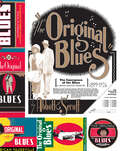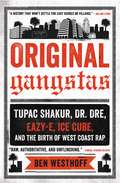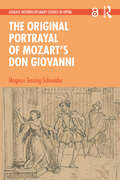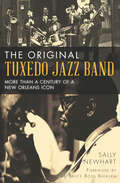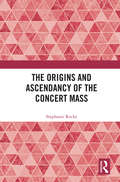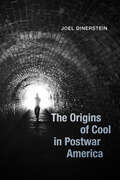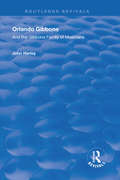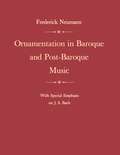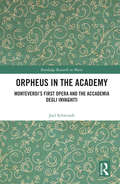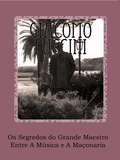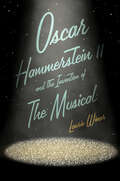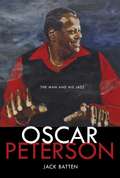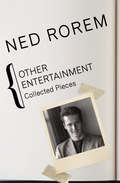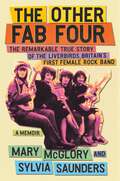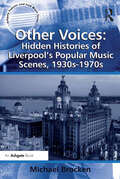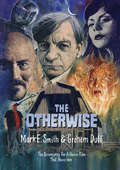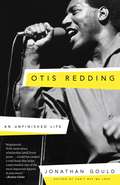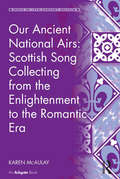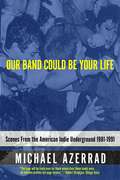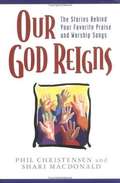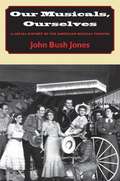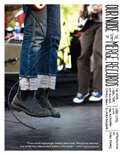- Table View
- List View
The Original Blues: The Emergence of the Blues in African American Vaudeville (American Made Music Series)
by Lynn Abbott Doug SeroffBlues Book of the Year —Living BluesAssociation of Recorded Sound Collections Awards for Excellence Best Historical Research in Recorded Blues, Gospel, Soul, or R&B–Certificate of Merit (2018)2023 Blues Hall of Fame Inductee - Classic of Blues Literature categoryWith this volume, Lynn Abbott and Doug Seroff complete their groundbreaking trilogy on the development of African American popular music. Fortified by decades of research, the authors bring to life the performers, entrepreneurs, critics, venues, and institutions that were most crucial to the emergence of the blues in black southern vaudeville theaters; the shadowy prehistory and early development of the blues is illuminated, detailed, and given substance.At the end of the nineteenth century, vaudeville began to replace minstrelsy as America’s favorite form of stage entertainment. Segregation necessitated the creation of discrete African American vaudeville theaters. When these venues first gained popularity, ragtime coon songs were the standard fare. Insular black southern theaters provided a safe haven, where coon songs underwent rehabilitation and blues songs suitable for the professional stage were formulated. The process was energized by dynamic interaction between the performers and their racially-exclusive audience.The first blues star of black vaudeville was Butler “String Beans” May, a blackface comedian from Montgomery, Alabama. Before his bizarre, senseless death in 1917, String Beans was recognized as the “blues master piano player of the world.” His musical legacy, elusive and previously unacknowledged, is preserved in the repertoire of country blues singer-guitarists and pianists of the race recording era.While male blues singers remained tethered to the role of blackface comedian, female “coon shouters” acquired a more dignified aura in the emergent persona of the “blues queen.” Ma Rainey, Bessie Smith, and most of their contemporaries came through this portal; while others, such as forgotten blues heroine Ora Criswell and her protégé Trixie Smith, ingeniously reconfigured the blackface mask for their own subversive purposes.In 1921 black vaudeville activity was effectively nationalized by the Theater Owners Booking Association (T.O.B.A.). In collaboration with the emergent race record industry, T.O.B.A. theaters featured touring companies headed by blues queens with records to sell. By this time the blues had moved beyond the confines of entertainment for an exclusively black audience. Small-time black vaudeville became something it had never been before—a gateway to big-time white vaudeville circuits, burlesque wheels, and fancy metropolitan cabarets. While the 1920s was the most glamorous and remunerative period of vaudeville blues, the prior decade was arguably even more creative, having witnessed the emergence, popularization, and early development of the original blues on the African American vaudeville stage.
Original Gangstas: The Untold Story of Dr. Dre, Eazy-E, Ice Cube, Tupac Shakur, and the Birth of West Coast Rap
by Ben Westhoff"Raw, authoritative, and unflinching ... An elaborately detailed, darkly surprising, definitive history of the LA gangsta rap era."---Kirkus, starred reviewA monumental, revealing narrative history about the legendary group of artists at the forefront of West Coast hip-hop: Eazy-E, Dr. Dre, Ice Cube, Snoop Dogg, and Tupac Shakur.Amid rising gang violence, the crack epidemic, and police brutality, a group of unlikely voices cut through the chaos of late 1980s Los Angeles: N.W.A. Led by a drug dealer, a glammed-up producer, and a high school kid, N.W.A gave voice to disenfranchised African Americans across the country. And they quickly redefined pop culture across the world. Their names remain as popular as ever--Eazy-E, Dr. Dre, and Ice Cube. Dre soon joined forces with Suge Knight to create the combustible Death Row Records, which in turn transformed Snoop Dogg and Tupac Shakur into superstars.Ben Westhoff explores how this group of artists shifted the balance of hip-hop from New York to Los Angeles. He shows how N.W.A.'s shocking success lead to rivalries between members, record labels, and eventually a war between East Coast and West Coast factions. In the process, hip-hop burst into mainstream America at a time of immense social change, and became the most dominant musical movement of the last thirty years. At gangsta rap's peak, two of its biggest names--Tupac and Biggie Smalls--were murdered, leaving the surviving artists to forge peace before the genre annihilated itself. Featuring extensive investigative reporting, interviews with the principal players, and dozens of never-before-told stories, Original Gangstas is a groundbreaking addition to the history of popular music.
The Original Portrayal of Mozart’s Don Giovanni (Ashgate Interdisciplinary Studies in Opera)
by Magnus Tessing SchneiderThe Original Portrayal of Mozart’s Don Giovanni offers an original reading of Mozart’s and Da Ponte’s opera Don Giovanni, using as a lens the portrayal of the title role by its creator, the baritone Luigi Bassi (1766–1825). Although Bassi was coached in the role by the composer himself, his portrayal has never been studied in depth before, and this book presents a large number of new sources (first- and second-hand accounts), which allows us to reconstruct his performance scene by scene. The book confronts Bassi’s portrayal with a study of the opera’s early German reception and performance history, demonstrating how Don Giovanni as we know it today was not only created by Mozart, Da Ponte and Luigi Bassi but also by the early German adapters, translators, critics and performers who turned the title character into the arrogant and violent villain we still encounter in most of today’s stage productions. Incorporating discussion of dramaturgical thinking of the late Enlightenment and the difficult moral problems that the opera raises, this is an important study for scholars and researchers from opera studies, theatre and performance studies, music history as well as conductors, directors and singers.
The Original Tuxedo Jazz Band: More Than a Century of a New Orleans Icon (Music Ser.)
by Sally NewhartA lively look at the long career of these legendary musicians, from a Storyville dance hall to the White House and beyond. In 1910, the Tuxedo Jazz Band played its first show at the Tuxedo Dance Hall in Storyville under Oscar Celestin. The popular ensemble would go on to play all over New Orleans, as well as across the South and the nation—and in 1953, it became the first jazz band to play the White House. The band has punctuated jazz history and produced some of the most memorable musicians of the past century: Bob French, Albert French, William Ridgley, Octave Crosby, Louis Armstrong, and more. Author Sally Newhart has written a definitive and captivating history of the band from inception to present, including oral histories, archival photos, a discography, and a previously unpublished complete list of members since 1910.
The Origins and Ascendancy of the Concert Mass
by Stephanie RockeThe mass is an extraordinary musical form. Whereas other Western art music genres from medieval times have fallen out of favour, the mass has not merely survived but flourished. A variety of historical forces within religious, secular, and musical arenas saw the mass expand well beyond its origins as a cycle of medieval chants, become concertised and ultimately bifurcate. Even as Western societies moved away from their Christian origins to become the religiously plural and politically secular societies of today, and the Church itself moved in favour of congregational singing, composers continued to compose masses. By the early twentieth century two forms of mass existed: the liturgical mass composed for church services, and the concert mass composed for secular venues. Spanning two millennia, The Origins and Ascendancy of the Concert Mass outlines the origins and meanings of the liturgical texts, defines the concert mass, explains how and why the split occurred, and provides examples that demonstrate composers’ gradual appropriation of the genre as a vehicle for personal expression on serious issues. By the end of the twentieth century the concert mass had become a repository for an eclectic range of theological and political ideas.
The Origins of Cool in Postwar America
by Joel DinersteinAn “entertaining” study of the enduring concept of coolness, and the mix of cultures and historical events that shaped it (The New York Times).Cool. It was a new word and a new way to be, and in a single generation, it became the supreme compliment of American culture. The Origins of Cool in Postwar America uncovers the hidden history of this concept and its new set of codes that came to define a global attitude and style. As Joel Dinerstein reveals, cool began as a stylish defiance of racism, a challenge to suppressed sexuality, a philosophy of individual rebellion, and a youthful search for social change.Through portraits of iconic figures, he illuminates the cultural connections and artistic innovations among Lester Young, Humphrey Bogart, Robert Mitchum, Billie Holiday, Frank Sinatra, Jack Kerouac, Albert Camus, Marlon Brando, James Dean, and others. We eavesdrop on conversations among Jean-Paul Sartre, Simone de Beauvoir, and Miles Davis, and on a forgotten debate between Lorraine Hansberry and Norman Mailer over the “white Negro” and black cool. We come to understand how the cool worlds of Beat writers and Method actors emerged from the intersections of film noir, jazz, and existentialism. Out of this mix, Dinerstein sketches nuanced definitions of cool that unite concepts from African-American and Euro-American culture: the stylish stoicism of the ethical rebel loner; the relaxed intensity of the improvising jazz musician; the effortless physical grace of the Method actor. To be cool is not to be hip and to be hot is definitely not to be cool.“Eminently readable. Much more than just a history of cool, this book is a studied examination of the very real, often problematic social issues that popular culture responds to.” —Publishers Weekly (starred review)“The kind of book that makes learning enjoyable.” —The Wall Street Journal“Superb.” —Times Higher Education
Orlando Gibbons and the Gibbons Family of Musicians (Routledge Revivals)
by John HarleyFirst published in 1999, this volume is the first full-length study to deal with the life and music of Orlando Gibbons since E.H. Fellowes’s short book, originally published in 1923. John Harley investigates in detail the family and musical background from which Orlando Gibbons emerged, and gives a fascinating account of the activities of his father, William Gibbons, as a wait in Oxford and Cambridge. He traces, too, the activities of Orlando’s brothers – Edward, who was the master of the choristers at King’s College, Cambridge and later at Exeter Cathedral; Ferdinando, who may have taken over from his father as head of the Cambridge waits, and who became a wait in Lincoln; and Ellis, who contributed two madrigals to Thomas Morley’s collection of 1601, The Triumphs of Oriana. Attention naturally focuses principally on Orlando Gibbons. A full record is given of his remarkably youthful appointment as an organist of the Chapel Royal (he was probably less than twenty at the time) and of his life at court. His additional appointments as one of Prince Charles’s musicians and as organist of Westminster Abbey are also described, as is his sudden and premature death in his early forties. Gibbons’s music is carefully examined in a series of chapters dealing with his pieces for keyboard and for viols, his songs, his full and verse anthems, and his works for the Anglican liturgy. His development as a composer within these genres is followed, and the character of particular pieces is considered. John Harley concludes that whereas, at one time, Gibbons ‘tended to be admired as a successor to Tallis and Byrd, working in a style not essentially different from theirs’, it is now ‘easier to view him as a pioneer, whose work was cut short by his untimely death’. Orlando Gibbons’s son Christopher was only a child when his father died, but he became one of the foremost composers and keyboard players of his generation, writing and performing chamber works and music for the stage during the Commonwealth. Following the Restoration of King Charles II, Christopher Gibbons gained his father’s former posts at the Chapel Royal and Westminster Abbey, for which establishments he wrote a number of anthems. His importance is recognized by the inclusion of a long chapter on his life and works.
Ornamentation in Baroque and Post-Baroque Music, with Special Emphasis on J.S. Bach
by Frederick NeumannOrnaments play an enormous role in the music of the seventeenth and eighteenth centuries, and ambiguities in their notation (as well as their frequent omission in the score) have left doubt as to how composers intended them to be interpreted. Frederick Neumann, himself a violinist and conductor, questions the validity of the rigid principles applied to their performance. In this controversial work, available for the first time in paperback, he argues that strict constraints are inconsistent with the freedom enjoyed by musicians of the period.The author takes an entirely new look at ornamentation, and particularly that of J. S. Bach. He draws on extensive research in England, France, Germany, Italy, and the United States to show that prevailing interpretations are based on inadequate evidence. These restrictive interpretations have been far-reaching in their effect on style. By questioning them, this work continues to stimulate a reorientation in our understandiing of Baroque and post-Baroque music.
Orpheus in the Academy: Monteverdi's First Opera and the Accademia degli Invaghiti (Routledge Research in Music)
by Joel SchwindtThis book introduces a new perspective on Claudio Monteverdi's Orfeo (1607), a work widely regarded as the 'first great opera', by exploring the influence of the Mantuan Accademia deglia Invaghiti, the group which hosted the opera’s performance, and to which the libretto author, Alessandro Striggio the Younger, belonged. Arguing that the Invaghiti played a key role in shaping the development of Orfeo, the author explores the philosophical underpinnings of the Invaghiti and Italian academies of the era. Drawing on new primary sources, he shows how the Invaghiti’s ideas about literature, dramaturgy, music, gender, and aesthetics were engaged and contested in the creation and staging of Orfeo. Relevant to researchers of music history, performance, and Renaissance and Baroque Italy, this study sheds new light on Monteverdi’s opera as an intellectual and philosophical work.
Orpheus in the Marketplace
by Tim Carter Richard A. GoldthwaiteThe Florentine musician Jacopo Peri (1561-1633) is known as the composer of the first operas--they include the earliest to survive complete, Euridice (1600), in which Peri sang the role of Orpheus. The recent discovery of a large number of private account books belonging to him and his family allows for a greater exploration of Peri's professional and personal life. Richard Goldthwaite, an economic historian, and Tim Carter, a musicologist, have done more, however, than write a biography: their investigation exposes the value of such financial documents as a primary source for an entire period. This record of Peri's wide-ranging investments and activities in the marketplace enables the first detailed account of the Florentine economy in the late sixteenth and early seventeenth centuries, and opens a new perspective on one of Europe's principal centers of capitalism. His economic circumstances reflect continuities and transformations in Florentine society, and the strategies for negotiating them, under the Medici grand dukes. They also allow a reevaluation of Peri the singer and composer that elucidates the cultural life of a major artistic center even in changing times, providing a quite different view of what it meant to be a musician in late Renaissance Italy.
Os Segredos do Grande Maestro: Entre A Música e A Maçonaria
by Paolo NutiGiacomo Puccini e a maçonaria: que ligação há entre um dos maiores compositores italianos de todos os tempos e essa controversa associação? Em uma erudita mescla entre romance e autobriografia, o autor junta anedotas pessoais a registros históricos, levantando dúvidas, colocando interrogações, e acompanhando o leitor em uma fascinante viagem para descobrir os segredos do Grande Maestro.
Oscar Hammerstein II and the Invention of the Musical
by Laurie WinerA new look at artist Oscar Hammerstein II as a pivotal and underestimated force in the creation of modern American culture You know his work—Show Boat, Oklahoma!, Carousel, The King and I. But you don’t really know Oscar Hammerstein II, the man who, more than anyone else, invented the American musical. Among the most commercially successful artists of his time, he was a fighter for social justice who constantly prodded his audiences to be better than they were. Diving deep into Hammerstein’s life, examining his papers and his lyrics, critic Laurie Winer shows how he orchestrated a collective reimagining of America, urging it forward with a subtly progressive vision of the relationship between country and city, rich and poor, America and the rest of the world. His rejection of bitterness, his openness to strangers, and his optimistic humor shaped not only the musical but the American dream itself. His vision can continue to be a touchstone to this day.
Oscar Peterson: The Man and His Jazz
by Jack BattenCalled the "Maharaja of the keyboard" by Duke Ellington, Oscar Peterson released over 200 recordings, won seven Grammy Awards, received the Order of Canada and is considered to have been one of the greatest jazz pianists of all time. This new biography from award-winning author Jack Batten, promises to tell Oscar Peterson's story in acomplete, compelling and sympathetic way. This is first biography of Oscar Peterson for young people. This book is the story of a black kid from a Montreal ghetto who reached accliam in the great music halls of the world.
Other Entertainment: Collected Pieces
by Ned RoremA collection of insightful essays, interviews, and commentaries on music, art, and those who make it, from acclaimed author and Pulitzer Prize–winning composer Ned RoremIt is a rare artist who can deftly cross the boundaries separating one artistic endeavor from another. Contemporary American composer Ned Rorem is one of the able few, not only &“the world&’s best composer of art songs&” (Time magazine) but a remarkable purveyor of prose works, as well. Rorem&’s superb collection Other Entertainment features insightful and fascinating essays on music, musicians, and literature, as well as provocative interviews with well-known figures in the arts and elsewhere. Whether he&’s offering a cogent analysis of Benjamin Britten&’s published diaries, confronting John Simon on the famously acerbic film and theater reviewer&’s alleged homophobia, or providing in-depth commentary on the lives and accomplishments of major artists and musical colleagues—as well as moving obituaries for those we have lost—Rorem proves himself to be as entertaining and controversial a social and cultural critic as America has ever produced.
The Other Fab Four: The Remarkable True Story of the Liverbirds, Britain's First Female Rock Band
by Mary McGlory Sylvia SaundersFor readers of Sheila Weller&’s Girls Like Us comes a fiercely feminist, heartwarming story of friendship and music about The Liverbirds, Britain&’s first all-female rock group. The idea for Britain&’s first female rock band, The Liverbirds, started one evening in 1962, when Mary McGlory, then age 16, saw The Beatles play live at The Cavern Club in Liverpool, the nightclub famously known as the &“cradle of British pop music.&” Then and there, she decided she was going to be just like them—and be the first girl to do it. Joining ranks in 1963 with three other working-class girls from Liverpool—drummer Sylvia Saunders and guitarists Valerie Gell and Pamela Birch, also self-taught musicians determined to &“break the male monopoly of the beat world&”—The Liverbirds went on to tour alongside the Rolling Stones, the Kinks, and Chuck Berry, and were on track to hit international stardom—until life intervened, and the group was forced to disband just five years after forming in 1968. Now, Mary and Sylvia, the band&’s two surviving members, are ready to tell their stories. From that fateful night in 1962, when Mary, who once aspired to become a nun, decided to provide for her family by becoming a rich-and-famous rocker, to the circumstances that led to the band splitting up—Sylvia&’s dangerously complicated pregnancy, and the tragic accident that paralyzed Valerie&’s beau—The Liverbirds tackles family, friendship, addiction, aging, and the forces—even destiny—that initially brought the four women together.
Other Voices: Hidden Histories Of Liverpool's Popular Music Scenes 1930s-1970s (Ashgate Popular and Folk Music Series)
by Michael BrockenAt times it appears that a whole industry exists to perpetuate the myth of origin of the Beatles. There certainly exists a popular music (or perhaps 'rock') origin myth concerning this group and the city of Liverpool and this draws in devotees, as if on a pilgrimage, to Liverpool itself. Once 'within' the city, local businesses exist primarily to escort these pilgrims around several almost iconic spaces and places associated with the group. At times it all almost seems 'spiritual'. One might argue however that, like any function myth, the music history of the Liverpool in which the Beatles grew and then departed is not fully represented. Beatles historians and businessmen-alike have seized upon myriad musical experiences and reworked them into a discourse that homogenizes not only the diverse collective articulations that initially put them into place, but also the receptive practices of those travellers willing to listen to a somewhat linear, exclusive narrative. Other Voices therefore exists as a history of the disparate and now partially hidden musical strands that contributed to Liverpool's musical countenance. It is also a critique of Beatles-related institutionalized popular music mythology. Via a critical historical investigation of several thus far partially hidden popular music activities in pre- and post-Second World War Liverpool, Michael Brocken reveals different yet intrinsic musical and socio-cultural processes from within the city of Liverpool. By addressing such 'scenes' as those involving dance bands, traditional jazz, folk music, country and western, and rhythm and blues, together with a consideration of partially hidden key places and individuals, and Liverpool's first 'real' record label, an assemblage of 'other voices' bears witness to an 'other', seldom discussed, Liverpool. By doing so, Brocken - born and raised in Liverpool - asks questions about not only the historicity of the Beatles-Liverpool narrative, but also about the absence o
The Other Worlds of Hector Berlioz
by Inge Van RijBerlioz frequently explored other worlds in his writings, from the imagined exotic enchantments of New Zealand to the rings of Saturn where Beethoven's spirit was said to reside. The settings for his musical works are more conservative, and his adventurousness has instead been located in his mastery of the orchestra, as both orchestrator and conductor. Inge van Rij's book takes a new approach to Berlioz's treatment of the orchestra by exploring the relationship between these two forms of control - the orchestra as abstract sound, and the orchestra as collective labour and instrumental technology. Van Rij reveals that the negotiation between worlds characteristic of Berlioz's writings also plays out in his music: orchestral technology may be concealed or ostentatiously displayed; musical instruments might be industrialised or exoticised; and the orchestral musicians themselves move between being a society of distinctive individuals and being a machine played by Berlioz himself.
The Otherwise: The Screenplay for a Horror Film That Never Was
by Mark E Smith Graham DuffThe first ever publication of Mark E. Smith's supernatural film treatment, co-authored with Graham Duff.In 2015 Mark E. Smith of The Fall and screenwriter Graham Duff co-wrote the script for a horror feature film called The Otherwise. The story involved The Fall recording an EP in an isolated recording studio on Pendle Hill. The Lancashire landscape is not only at the mercy of a satanic biker gang, it's also haunted by a gaggle of soldiers who have slipped through time from the Jacobite Rebellion.However, every film production company who saw the script said it was 'too weird' to ever be made. The Otherwise is weird. Yet it's also witty, shocking and genuinely scary. Now the screenplay is published for the first time, alongside photographs, drawings and handwritten notes. The volume also contains previously unpublished transcripts of conversations between Smith and Duff, where they discuss creativity, dreams, musical loves (from Can to acid house) and favourite films (from Britannia Hospital to White Heat). Smith also talks candidly about his youth and mortality, in exchanges that are both touching and extremely funny.
Otis Redding: An Unfinished Life
by Jonathan GouldThe long-awaited, definitive biography of The King of Soul, timed to coincide with the 50th anniversary of Redding's iconic performance at the 1967 Monterey Pop Festival. Otis Redding remains an immortal presence in the canon of American music on the strength of such classic hits as “(Sittin’ on) The Dock of the Bay,” “I’ve Been Loving You Too Long,” “Try a Little Tenderness,” and “Respect,” a song he wrote and recorded before Aretha Franklin made it her own. As the architect of the distinctly southern, gospel-inflected style of rhythm & blues associated with Stax Records in Memphis, Redding made music that has long served as the gold standard of 1960s soul. Yet an aura of myth and mystery has always surrounded his life, which was tragically cut short at the height of his career by a plane crash in December 1967. In Otis Redding: An Unfinished Life, Jonathan Gould finally does justice to Redding’s incomparable musical artistry, drawing on exhaustive research, the cooperation of the Redding family, and previously unavailable sources of information to present the first comprehensive portrait of the singer’s background, his upbringing, and his professional career. In chronicling the story of Redding’s life and music, Gould also presents a social history of the time and place from which they emerged. His book never lets us forget that the boundaries between black and white in popular music were becoming porous during the years when racial tensions were reaching a height throughout the United States. His indelible portrait of Redding and the mass acceptance of soul music in the 1960s is both a revealing look at a brilliant artist and a provocative exploration of the tangled history of race and music in America that resonates strongly with the present day.
Our Ancient National Airs: Scottish Song Collecting From The Enlightenment To The Romantic Era (Music in Nineteenth-Century Britain)
by Karen McAulayOne of the earliest documented Scottish song collectors actually to go 'into the field' to gather his specimens, was the Highlander Joseph Macdonald. Macdonald emigrated in 1760 - contemporaneously with the start of James Macpherson's famous but much disputed Ossian project - and it fell to the Revd. Patrick Macdonald to finish and subsequently publish his younger brother's collection. Karen McAulay traces the complex history of Scottish song collecting, and the publication of major Highland and Lowland collections, over the ensuing 130 years. Looking at sources, authenticity, collecting methodology and format, McAulay places these collections in their cultural context and traces links with contemporary attitudes towards such wide-ranging topics as the embryonic tourism and travel industry; cultural nationalism; fakery and forgery; literary and musical creativity; and the move from antiquarianism and dilettantism towards an increasingly scholarly and didactic tone in the mid-to-late Victorian collections. Attention is given to some of the performance issues raised, either in correspondence or in the paratexts of published collections; and the narrative is interlaced with references to contemporary literary, social and even political history as it affected the collectors themselves. Most significantly, this study demonstrates a resurgence of cultural nationalism in the late nineteenth century.
Our Band Could Be Your Life: Scenes from the American Indie Underground, 1981-1991
by Michael AzerradThis is the never-before-told story of the musical revolution that happened right under the nose of the Reagan Eighties--when a small but sprawling network of bands, labels, fanzines, radio stations, and other subversives reenergized American rock with punk rock's do-it-yourself credo and created music that was deeply personal, often brilliant, always challenging, and immensely influential. This sweeping chronicle of music, politics, drugs, fear, loathing, and faith has been recognized as an indie rock classic in its own right. Among the bands profiled: Mission of Burma, Butthole Surfers, The Minutemen, Sonic Youth, Black Flag, Big Black, Hüsker Dü, Fugazi, Minor Threat, Mudhoney, The Replacements, Beat Happening, and Dinosaur Jr.
Our God Reigns: The Stories Behind Your Favorite Praise and Worship Songs
by Phil Christensen Shari MacdonaldPresents the stories behind twenty-five well-known worship songs including "I Want to Be Where You Are," "You Are My All in All," and "His Name Is Wonderful." Provides biographical sketches of the songwriters through a number of interviews and describes the major themes in each song.
Our Journey: Rak Su’s Official Autobiography. The X Factor Winners
by Rak-SuA shout-out to all fans of Rak-Su - this is their story, from where it all began to where they are now, full of exclusive stories and pictures. Make it a special day. Make it a Rak-Su day! __________Rak-Pack! Are you ready for our official story?As long as we've been friends, we've been creating our unique sound of soul, R'n'B, Hip-Hop, Latin and Caribbean music.Keeping the momentum going from our X-Factor journey, we are now performing at sold-out arenas, making more music and having fun!So why not join us on the adventure? Unrivalled access to never-before-seen photos, intimate stories, and behind-the-scenes info - in our first and only memoir!_________Ashley, Jamaal, Myles and Mustafa shot to stardom in 2017 as the first ever male group to win the X-Factor. Since then, the soulful boys have been topping the charts with their eclectic sound, performing at sold-out arenas, touring with global sensation Little Mix, recording their first album and most recently dropping their brand new hit single, Pyro Ting.Join Rak-Su on their journey from ordinary North-West London lads, to victors of one of the world's biggest talent shows in their one and ONLY! OFFICIAL memoir, Our Journey.
Our Musicals, Ourselves: A Social History of the American Musical Theatre
by John Bush JonesOur Musicals, Ourselves is the first full-scale social history of the American musical theater from the imported Gilbert and Sullivan comic operas of the late nineteenth century to such recent musicals as The Producers and Urinetown. While many aficionados of the Broadway musical associate it with wonderful, diversionary shows like The Music Man or My Fair Lady, John Bush Jones instead selects musicals for their social relevance and the extent to which they engage, directly or metaphorically, contemporary politics and culture. <P><P>Organized chronologically, with some liberties taken to keep together similarly themed musicals, Jones examines dozens of Broadway shows from the beginning of the twentieth century to the present that demonstrate numerous links between what played on Broadway and what played on newspapers' front pages across our nation. He reviews the productions, lyrics, staging, and casts from the lesser-known early musicals (the gunboat musicals of the Teddy Roosevelt era and the Cinderella shows and "leisure time musicals" of the 1920s) and continues his analysis with better-known shows including Showboat, Porgy and Bess, Oklahoma, South Pacific, West Side Story, Cabaret, Hair, Company, A Chorus Line, and many others. While most examinations of the American musical focus on specific shows or emphasize the development of the musical as an art form, Jones's book uses musicals as a way of illuminating broader social and cultural themes of the times. With six appendixes detailing the long-running diversionary musicals and a foreword by Sheldon Harnick, the lyricist of Fiddler on the Roof, Jones's comprehensive social history will appeal to both students and fans of Broadway.
Our Noise: The Story of Merge Records, the Indie Label That Got Big and Stayed Small
by John Cook Laura Ballance Mac McCaughanMerge Records defies everything you’ve heard about the music business. Started by two twenty-year-old musicians, Merge is a lesson in how to make and market great music on a human scale. The fact that the company is prospering in a failing industry is something of a miracle. Yet two of their bands made the Billboard Top 10 list; more than 1 million copies of Arcade Fire's Neon Bible have been sold; Spoon has appeared on Saturday Night Live and The Tonight Show; and the Magnetic Fields' 69 Love Songs is a contemporary classic. In celebration of their twentieth anniversary, founders Mac and Laura offer first-person accounts—with the help of their colleagues and Merge artists—of their work, their lives, and the culture of making music. Our Noise also tells the behind-the-scenes stories of Arcade Fire, Spoon, the Magnetic Fields, Superchunk, Lambchop, Neutral Milk Hotel, and Butterglory. Hundreds of personal photos of the bands, along with album cover art, concert posters, and other memorabilia are included.
